-
You cannot add another "Processional Drummers" to your cart. View cart
-
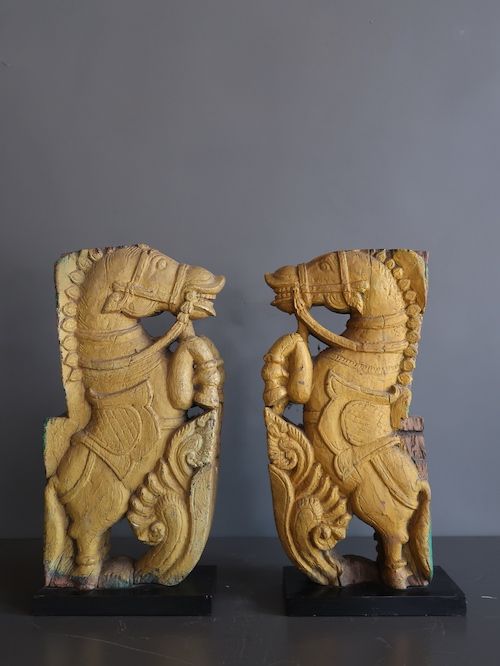
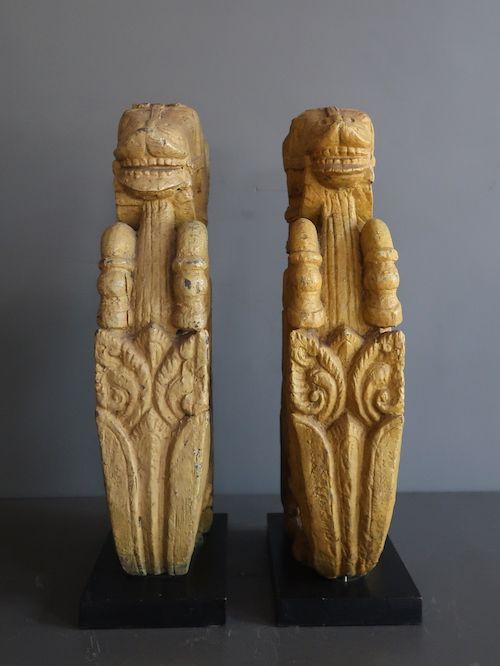
Andhra Pradesh (South India)
Wood, polychromed
These horse brackets once formed the two ends of a door lintel. The horse or ashva was a very popular motif in architectural wood carvings in South India. Its prototype, the divine Uchchaihshravas emerged from the churning of the ocean. It was white and endowed with wings. The god Indra appropriated it and, after cutting its wings to ensure that it would remain on earth, donated it to mankind.
The horse played a pivotal role in establishing the supremacy of kings, as demonstrated, for instance by the great horse sacrifice, the Ashvamedha, which might have been established in the course of the Vedic period. Equestrian motifs appear prominently in Indian art, for example in Orissan sculpture of the 12th and 13th centuries, and in that of the late Vijaynagara and Nayak periods (early 16th to early 18th century) in southern India. There is a branch of literature specialising in the training of horses, which contains detailed passages on colouring, proportions, gait, auspicious and inauspicious marks and lists of appropriate names for horses.
Size individual (cms): 47 (H) x 10 (W) x 23 (D)
Size individual (inches): 18.5 (H) x 4 (W) x 9 (D)
-
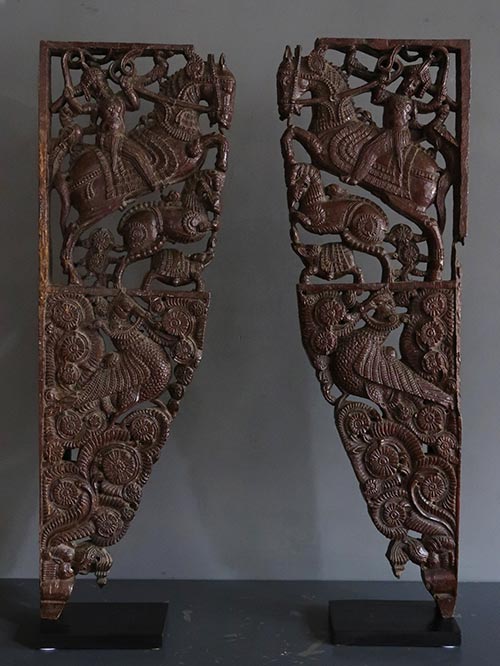
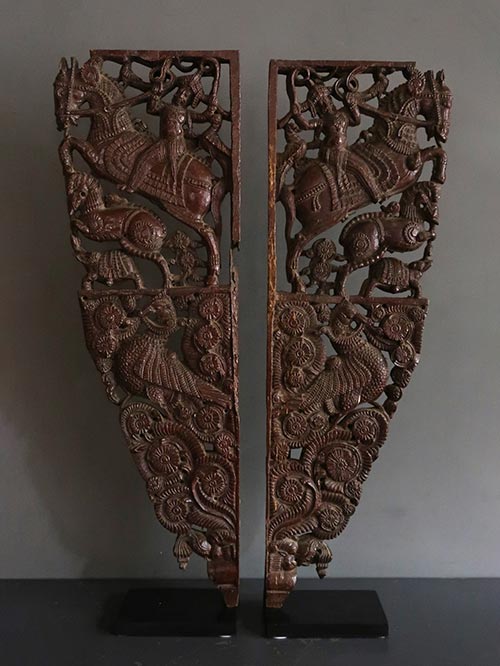
Tamil Nadu
Wood
A pair of extremely fine and large carved and pierced doorway brackets, from the entrance door of a Chettinad mansion. They depict a dense arrangement comprising elaborately caparisoned rearing horses with turbaned and ornamented riders holding whips in the upper register. The pointed turbans worn by these riders is an indication of their royal status. The raised forelegs of the horses rest on the heads of rearing Vyalis – open mouthed and with bulging eyes, who in turn are supported by the trunks of diminutive elephants. At the lower end are parrots perched vertically. The remarkable density of the composition is achieved by filling almost every available space with swirling foliage.
Size individual (cms): 96 (H) x 31 (W) x 15 (D)
Size individual (inches): 37.8 (H) x 12.2 (W) x 6 (D)
-
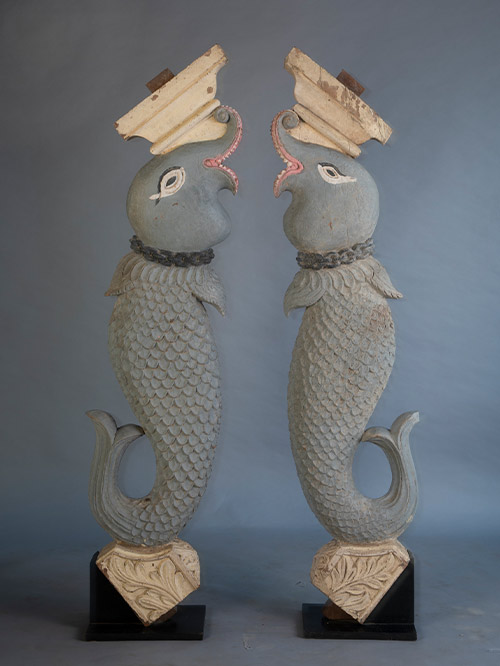
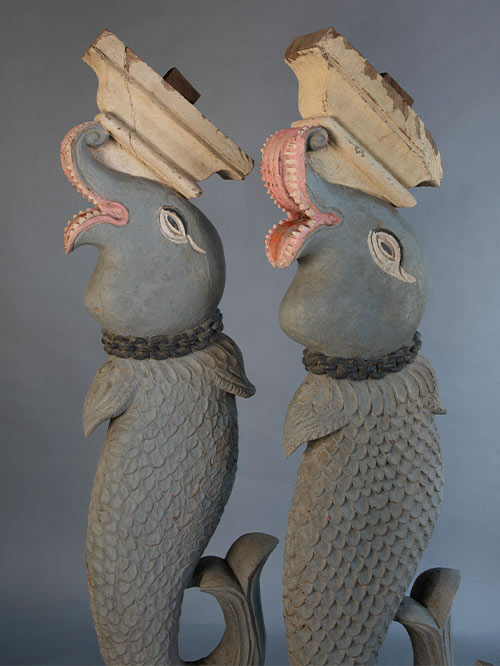
Gujarat (Western India)
Wood with polychrome
An unusual and impressive set of carved makara brackets (architectural struts) probably originally from the upper pavilion of a mansion or temple. Their open mouths reveal rows of prominent teeth, the upper jaw is formed as a short upturned trunk. The necks have a linked chain, the lower body is encompassed by scales resembling a fish and have an upturned tail.
The Makara is a mythical aquatic creature that is said to combine the body of a crocodile with the head of a lion and the trunk of an elephant. One of India’s most ancient symbols, harking back more than two thousand years to a time when the natural world was seen as both symbol and reality, and fantastic creatures were invented to express the complexity of nature. The Makara is considered auspicious and purifying by Hindus and related to fertility. He is the vehicle (vahana) of Varuna, god of the waters of heaven and earth, and the emblem of Kama, the god of love.
Individual Sizes (cms): 155(H) x 38(W) x 21(D)
Individual Sizes (inches): 61(H) x 15(W) x 8.5(D)
-
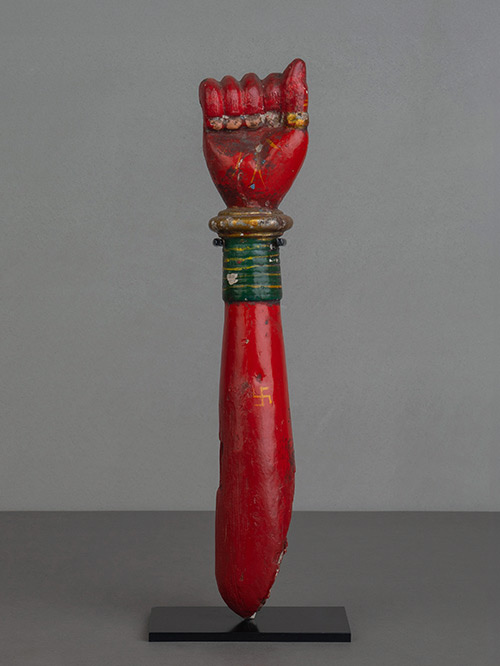
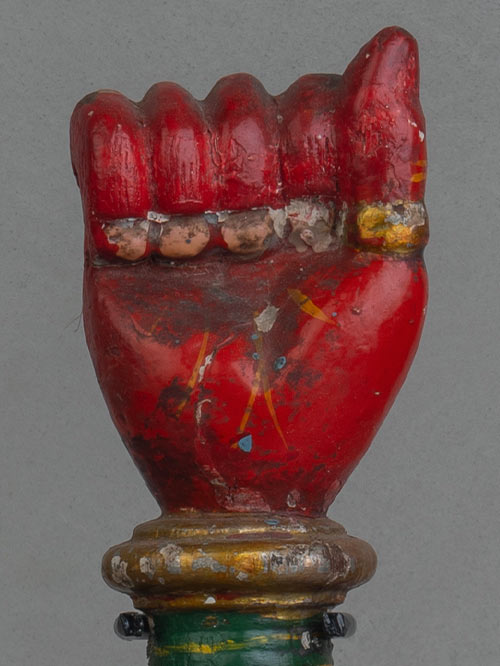
Karnataka
Wood, polychromed
A finely carved wooden hand, with original polychroming wearing bangles. Her hand is held in a clenched fist. Originally from an articulated multi-armed processional figure of a Devi. During festive occasions, the utsavar (portable figures of deities) are placed on chariots or pedestals in the mandapam (audience hall of a temple) or on their respective vahana (vehicle) and taken out for public viewing or darshana. Darshana refers to the occasion where the devotee is not only able to see the image of the deity but also to sense its omnipresence. To enhance the visibility of the utsavar, they are elaborately dressed in dhoti or sari, garlanded with flowers and decked with the most exquisite jewellery, made of gold and semi-precious stones before being brought out in procession. Sometimes additional hands or legs are added to increase the physical presence of the image. These features may allow the deity to stand, sit or clasp multiple weapons.
Size with the Stand (cms): 36.5(H) x 13(W) x 7.5(D)
Size with the Stand (inches):14.5(H) x 5(W) x 3(D)
-
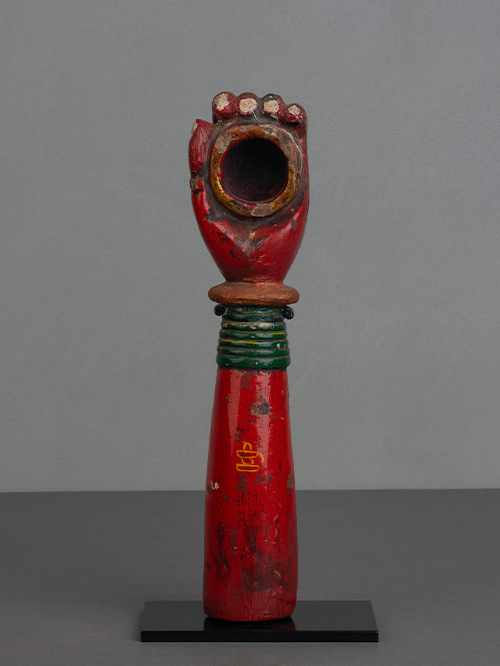
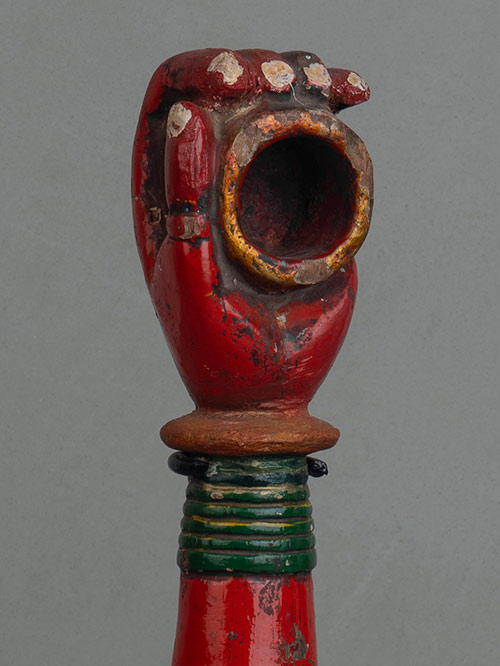
Karnataka
Wood, polychromed
A finely carved wooden hand, with original polychroming wearing bangles. She holds a blood bowl within her clenched fist and a diminutive lingam marks her forearm. Originally from an articulated multi-armed processional figure of a Devi. During festive occasions, the utsavar (portable figures of deities) are placed on chariots or pedestals in the mandapam (audience hall of a temple) or on their respective vahana (vehicle) and taken out for public viewing or darshana. Darshana refers to the occasion where the devotee is not only able to see the image of the deity but also to sense its omnipresence. To enhance the visibility of the utsavar, they are elaborately dressed in dhoti or sari, garlanded with flowers and decked with the most exquisite jewellery, made of gold and semi-precious stones before being brought out in procession. Sometimes additional hands or legs are added to increase the physical presence of the image. These features may allow the deity to stand, sit or clasp multiple weapons.
Size with the Stand (cms):29(H) x 13(W) x 7.5(D)
Size with the Stand (inches): 11.5(H) x 5(W) x 3(D)
-

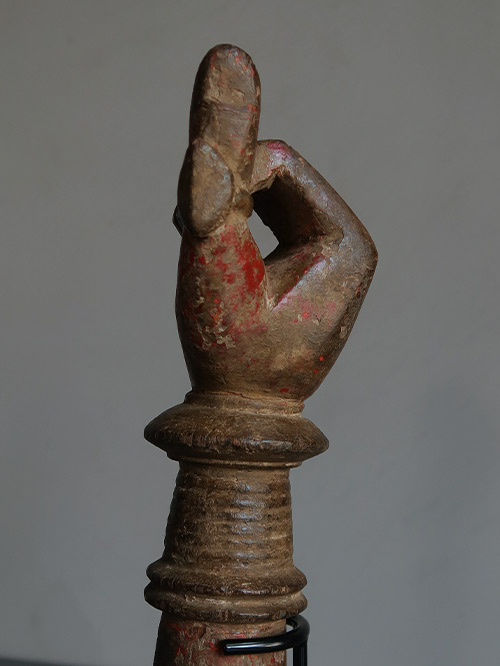
Karnataka
Wood, polychromed
A finely carved wooden hand, with original polychroming wearing bangles and rings. Originally from an articulated multi-armed processional figure of a Devi. During festive occasions, the utsavar (portable figures of deities) are placed on chariots or pedestals in the mandapam (audience hall of a temple) or on their respective vahana (vehicle) and taken out for public viewing or darshana. Darshana refers to the occasion where the devotee is not only able to see the image of the deity but also to sense its omnipresence. To enhance the visibility of the utsavar, they are elaborately dressed in dhoti or sari, garlanded with flowers and decked with the most exquisite jewellery, made of gold and semi-precious stones before being brought out in procession. Sometimes additional hands or legs are added to increase the physical presence of the image. These features may allow the deity to stand, sit or clasp multiple weapons.
Size with the Stand (cms): 34(H) x 13(W) x 7.5(D)
Size with the Stand (inches): 13.5(H) x 5(W) x 3(D)
-
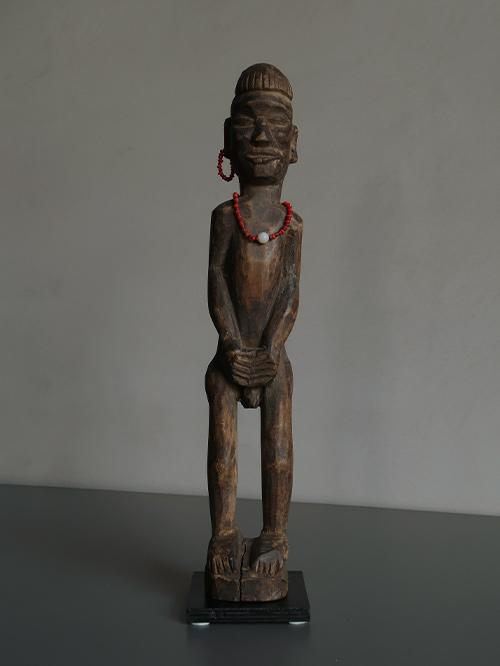

Nagaland (North-East India)
Wood
Male standing figure adorned with red and white glass bead necklaces. Carved from solid trunks of trees, the solemn expressions of these wood sculptures sometimes heightened by cowrie shells, bead necklaces or human and animal hair, combined with the blunt tubular carving on dark wood give these Naga figures a silent though persuasive identity.
A key fixture in nearly all Naga settlements was the Morung, or Men’s House, which served as something of a community center. It was usually the biggest and most beautifully furnished building in a village, spacious and decorated with ornate carvings. Numerous wooden sculptures decorated the walls and posts of the farthest end of the innermost space of the Morung. They expressed the narrative traditions of the Naga. Wooden sculpture such as this, depicting would be posted near the walls of the Morung, were not uncommon and thought to relate to fertility.
The Naga are a group of culturally and linguistically linked tribes who live in the mountainous regions of northeastern India and northwestern Burma (Myanmar). As headhunters, they were feared and avoided by their neighbours, allowing them to develop a distinctive material culture—in which objects they created are of impressive aesthetic value and possess great symbolic importance to the community—and a complex system of norms and taboos.
Size (cms): 46(H) x 9(W) x 7(D)
Size (inches): 18(H) x 3.5(W) x 3(D)
-
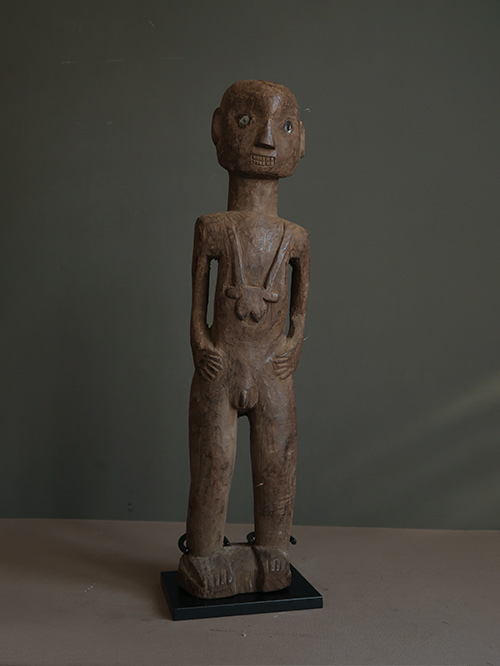
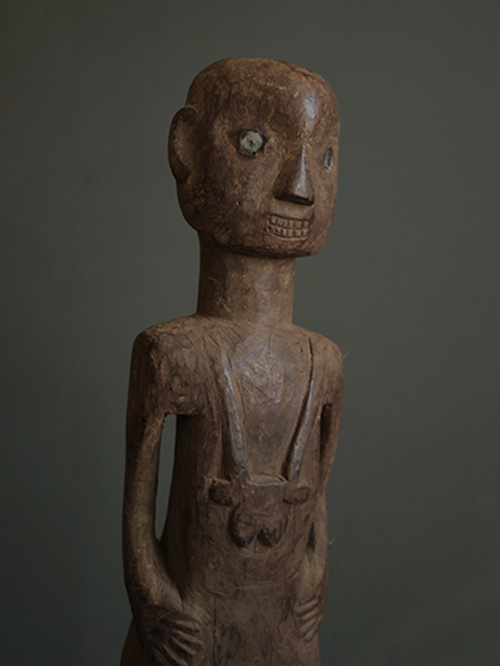
Nagaland (North-East India)
Wood and glass
A key fixture in nearly all Naga settlements was the Morung, or Men’s House, which served as something of a community center. It was usually the biggest and most beautifully furnished building in a village, spacious and decorated with ornate carvings. Numerous wooden sculptures decorated the walls and posts of the farthest end of the innermost space of the Morung. They expressed the narrative traditions of the Naga. Wooden sculpture such as this, depicting would be posted near the walls of the Morung, were not uncommon and thought to relate to fertility.
The Naga are a group of culturally and linguistically linked tribes who live in the mountainous regions of northeastern India and northwestern Burma (Myanmar). As headhunters, they were feared and avoided by their neighbours, allowing them to develop a distinctive material culture—in which objects they created are of impressive aesthetic value and possess great symbolic importance to the community—and a complex system of norms and taboos. The main tribal groups of the Naga include the Angami, Sema, Ao, Kalyo- Kengyu, Konyak, Lhota, Rengma, Tangkhul, Chang, Sangtam and Sema.
Size(cms): 53 (H) x 13 (W) x 8 (D)
Size(inches): 20.9 (H) x 5.1 (W) x 3.1 (D)
-
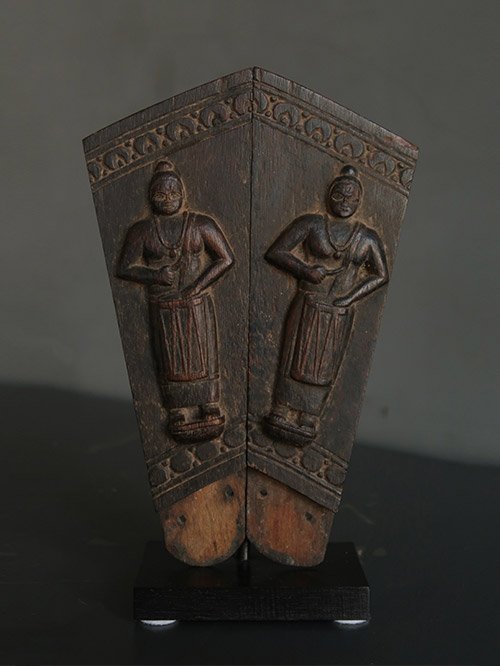
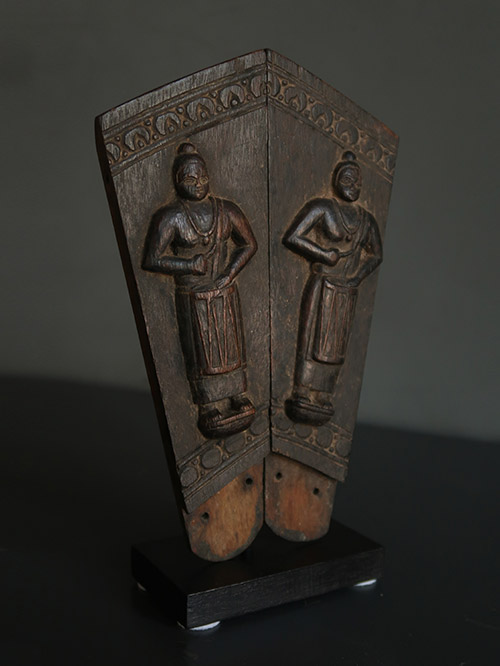
Northern Kerala (South India)
Wood
A fine pair of wedge shaped panels depicting a pair of musicians. Carved in low relief, the bare chested musicians wear dhotis and a simple necklace and have their hair tied up into buns. Conspicuously drawn on their foreheads are namams which are identification marks of Sri Vaishnavites. Their faces are locked in concentration as they play the chanda (cylindrical drum) that is strung over their shoulders. A band of geometric patterns frames the top and bottom of the panels.
Wedged shaped panels such as these would have been loosely strung together to form a ritual headpiece that would have been worn by the chief performer in ceremonial dances associated with temple festivals. The headpiece is boldly conceived , with a central figure of Gaja Laxmi, carved in high relief, seated on a lotus being lustrated by two elephants flanking her. Ten processional figures of musicians and attendants carrying staffs, drums, cymbals, trumpets etc. would have been depicted in low-relief on either side of the central motif.
Size(cms): 26 (H) x 15 (W) x 7 (D)
Size(inches): 10.2 (H) x 5.9 (W) x 2.7 (D)
-
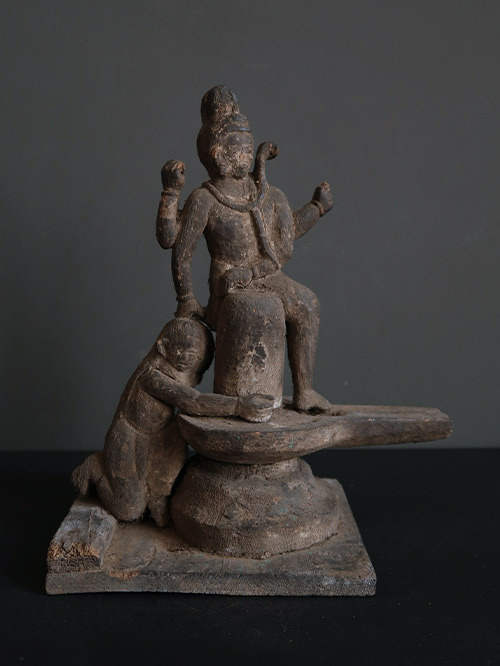

South India
Wood
An unusual group of figures depicting Markandeya embraces a linga. Four-armed Shiva is depicted emerging from the linga, splitting it apart, and with his right foot resting on the yoni. This incident is believed to have happened at Triprangode, Kerala where Lord Shiva appears and kills Yama when the latter appears to take the life of Markandeya who is one of Shiva’s ardent devotees.
Size (cms): 28 (H) x 23 (W) x 16 (D)
Size (inches): 11 (H) x 9 (W) x 6.3 (D)
-
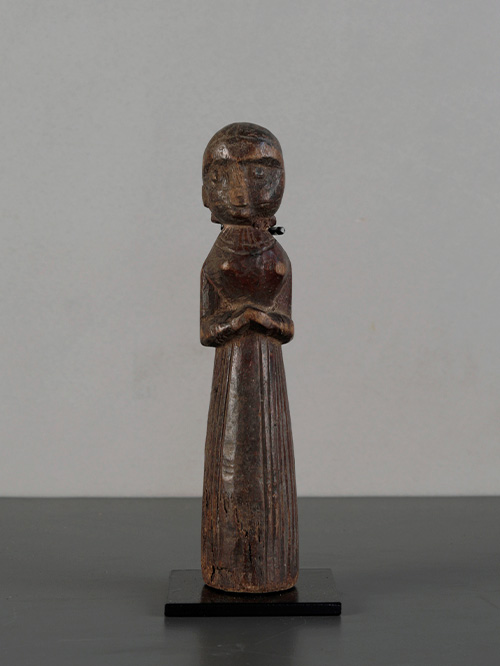
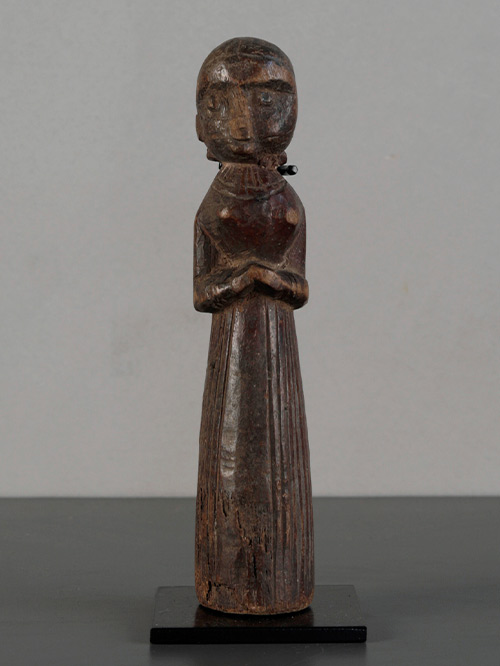
Maharashtra
Wood
A beautiful votive doll with its hands pressed in anjali mudra, a gesture of greeting and prayer. These small figures carved in wood, usually representing worshipping women, but also female water carriers, mothers, or pregnant women are simple in design, yet it is this implied simplicity that makes these figures attractive. They take various forms, triangular, rectangular, round or stepped. Often only the front of the sculptures are carved whereas the rears maybe left untreated. Often statuettes miss a nose, ears or arms. Many of the faces have been worn down from use, to a point where they reveal no detail.
These small figures were used for devotional purposes within the home, placed there as votive offerings to the Goddess Maulli/Mariai. Mauli is a powerful folk deity that protects against illness such as smallpox and cholera. But at the same time, neglecting her inflicts her wrath. She also takes the role of a fertility goddess to whom childless women seek respite. Figures of the Goddess are worshipped with turmeric, some red kunkum and oil which is daubed on her forehead.
Size (cms): 22(H) x 7.5(W) x 7.5(D)
Size (inches): 8.5(H) x 3(W) x 3(D)
-
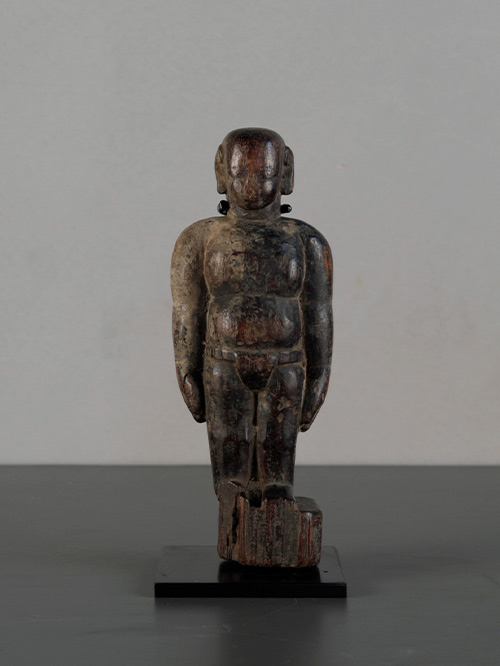
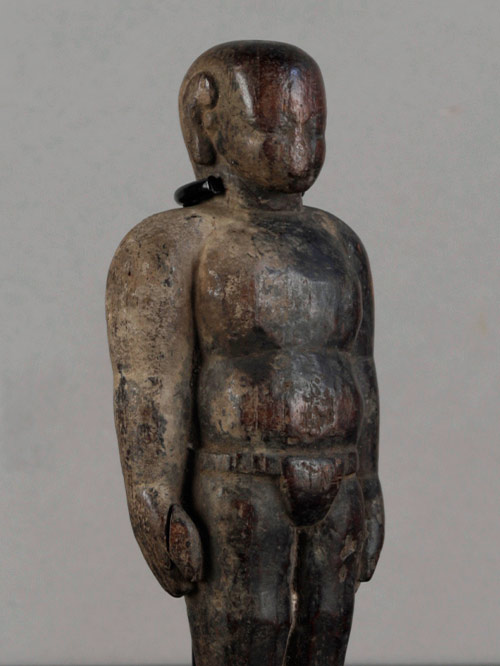
Maharashtra
Wood
An unusual wooden doll depicting a portly man standing at attention.
These small figures carved in wood, usually representing worshipping women, but also female water carriers, mothers, or pregnant women are simple in design, yet it is this implied simplicity that makes these figures attractive. They take various forms, triangular, rectangular, round or stepped. Often only the front of the sculptures are carved whereas the rears maybe left untreated. Often statuettes miss a nose, ears or arms. Many of the faces have been worn down from use, to a point where they reveal no detail.
These small figures were used for devotional purposes within the home, placed there as votive offerings to the Goddess Maulli/Mariai. Mauli is a powerful folk deity that protects against illness such as smallpox and cholera. But at the same time, neglecting her inflicts her wrath. She also takes the role of a fertility goddess to whom childless women seek respite. Figures of the Goddess are worshipped with turmeric, some red kunkum and oil which is daubed on her forehead.
Size (cms): 19(H) x 8(W) x 8(D)
Size (inches): 7.5(H) x 3(W) x 3(D)
-
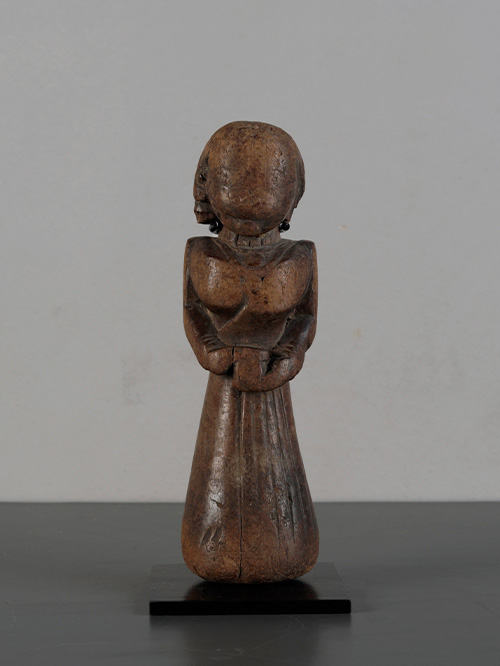
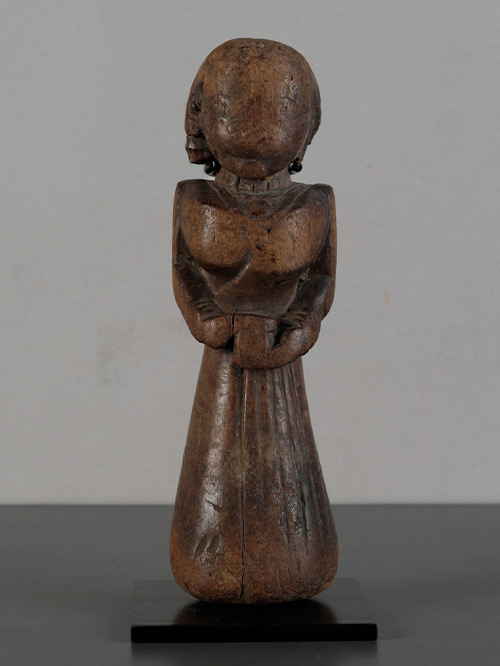
Maharashtra
Wood
A patinated votive doll with its hands pressed in anjali mudra, a gesture of greeting and prayer. These small figures carved in wood, usually representing worshipping women, but also female water carriers, mothers, or pregnant women are simple in design, yet it is this implied simplicity that makes these figures attractive. They take various forms, triangular, rectangular, round or stepped. Often only the front of the sculptures are carved whereas the rears maybe left untreated. Often statuettes miss a nose, ears or arms. Many of the faces have been worn down from use, to a point where they reveal no detail.
These small figures were used for devotional purposes within the home, placed there as votive offerings to the Goddess Maulli/Mariai. Mauli is a powerful folk deity that protects against illness such as smallpox and cholera. But at the same time, neglecting her inflicts her wrath. She also takes the role of a fertility goddess to whom childless women seek respite. Figures of the Goddess are worshipped with turmeric, some red kunkum and oil which is daubed on her forehead.
Size (cms): 22.5(H) x 9(W) x 9(D)
Size (inches): 9(H) x 3.5(W) x 3.5(D)
-
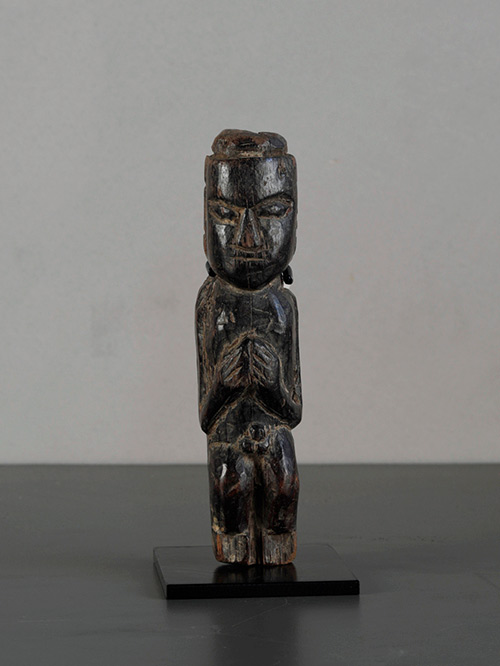
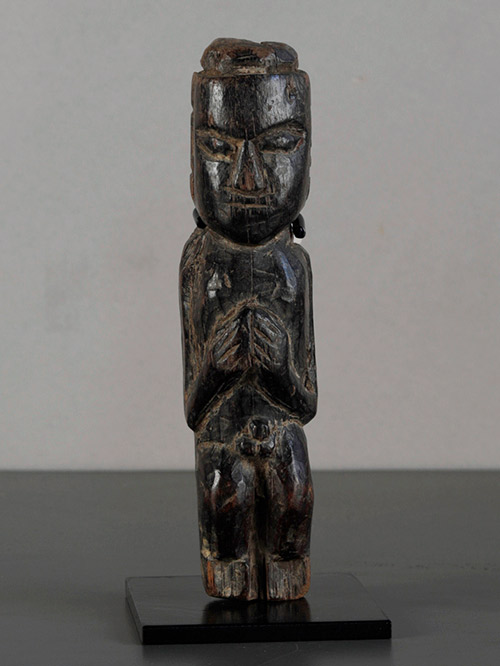
Maharashtra
Wood
A beautiful votive doll with its hands pressed in anjali mudra, a gesture of greeting and prayer. These small figures carved in wood, usually representing worshipping women, but also female water carriers, mothers, or pregnant women are simple in design, yet it is this implied simplicity that makes these figures attractive. They take various forms, triangular, rectangular, round or stepped. Often only the front of the sculptures are carved whereas the rears maybe left untreated. Often statuettes miss a nose, ears or arms. Many of the faces have been worn down from use, to a point where they reveal no detail.
These small figures were used for devotional purposes within the home, placed there as votive offerings to the Goddess Maulli/Mariai. Mauli is a powerful folk deity that protects against illness such as smallpox and cholera. But at the same time, neglecting her inflicts her wrath. She also takes the role of a fertility goddess to whom childless women seek respite. Figures of the Goddess are worshipped with turmeric, some red kunkum and oil which is daubed on her forehead.
Size (cms): 18(H) x 8(W) x 8(D)
Size (inches): 7(H) x 3(W) x 3(D)
-
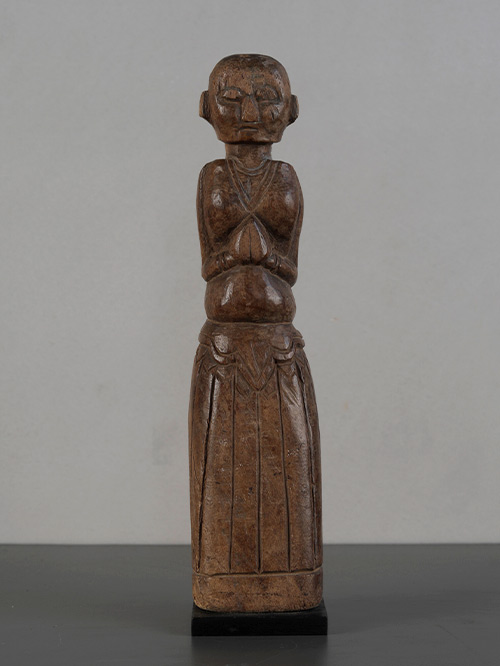
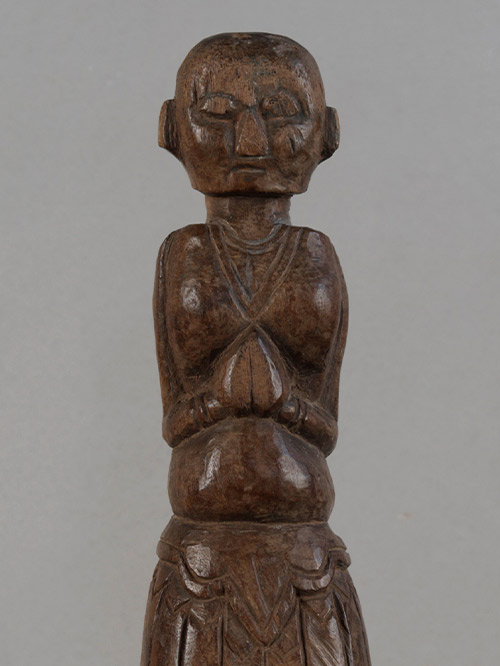
Maharashtra
Wood
A beautiful votive doll with its hands pressed in anjali mudra, a gesture of greeting and prayer. These small figures carved in wood, usually representing worshipping women, but also female water carriers, mothers, or pregnant women are simple in design, yet it is this implied simplicity that makes these figures attractive. They take various forms, triangular, rectangular, round or stepped. Often only the front of the sculptures are carved whereas the rears maybe left untreated. Often statuettes miss a nose, ears or arms. Many of the faces have been worn down from use, to a point where they reveal no detail.
These small figures were used for devotional purposes within the home, placed there as votive offerings to the Goddess Maulli/Mariai. Mauli is a powerful folk deity that protects against illness such as smallpox and cholera. But at the same time, neglecting her inflicts her wrath. She also takes the role of a fertility goddess to whom childless women seek respite. Figures of the Goddess are worshipped with turmeric, some red kunkum and oil which is daubed on her forehead.
Size (cms): 32(H) x 7.5(W) x 7(D)
Size (inches): 12.5(H) x 3(W) x 3(D)
-
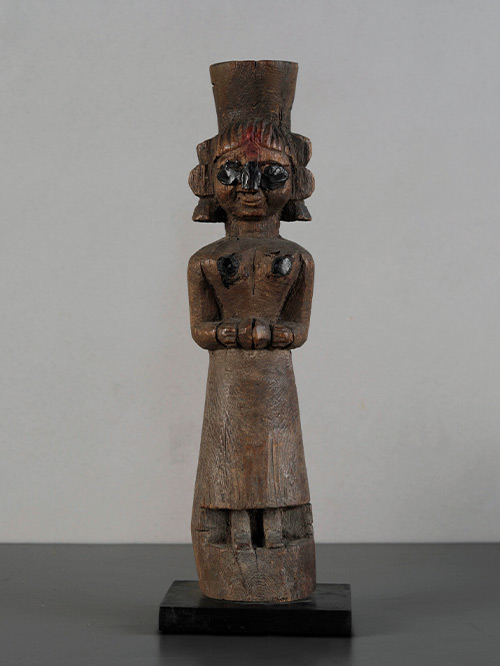

Maharashtra
Wood
A beautiful votive doll with its hands pressed in anjali mudra, a gesture of greeting and prayer. These small figures carved in wood, usually representing worshipping women, but also female water carriers, mothers, or pregnant women are simple in design, yet it is this implied simplicity that makes these figures attractive. They take various forms, triangular, rectangular, round or stepped. Often only the front of the sculptures are carved whereas the rears maybe left untreated. Often statuettes miss a nose, ears or arms. Many of the faces have been worn down from use, to a point where they reveal no detail.
These small figures were used for devotional purposes within the home, placed there as votive offerings to the Goddess Maulli/Mariai. Mauli is a powerful folk deity that protects against illness such as smallpox and cholera. But at the same time, neglecting her inflicts her wrath. She also takes the role of a fertility goddess to whom childless women seek respite. Figures of the Goddess are worshipped with turmeric, some red kunkum and oil which is daubed on her forehead.
Size (cms): 31.5(H) x 10.5(W) x 8(D)
Size (inches): 12.5(H) x 4(W) x 3(D)

































